Spring学习记录之Spring-AOP
前言
这篇文章是我第二次学习b站老杜的spring相关课程所进行的学习记录,算是对课程内容及笔记的二次整理,以自己的理解方式进行二次记录,其中理解可能存在错误,欢迎且接受各位大佬们的批评指正;
关于本笔记,只是我对于相关知识遗忘时快速查阅了解使用,至于课程中实际实验配置等,也只是记录关键,并不会记录详细步骤,若想了解可以关注我博客的项目经验模块,我会在实际项目开发过程中总结项目经验,在该模块发布!
学习视频地址:https://www.bilibili.com/video/BV1Ft4y1g7Fb/
视频配套笔记:https://www.yuque.com/dujubin/ltckqu/kipzgd?singleDoc# 《Spring6》 密码:mg9b
目录
一、我个人对这部分学习的一些见解
这部分需要重点掌握,是Spring提供的另一个核心功能,也是Spring系列项目开发中必不可少的功能之一,面向切面编程。
这部分我将继续引用老杜的笔记。
二、初始面向切面编程AOP
IoC使软件组件松耦合。AOP让你能够捕捉系统中经常使用的功能,把它转化成组件。
(一)代理模式和AOP的关系
AOP(Aspect Oriented Programming):面向切面编程,面向方面编程。(AOP是一种编程思想,具体实现是通过动态代理【比如JDK动态代理和CGLIB动态代理】来实现的。)
AOP底层使用的就是动态代理来实现的。
Spring的AOP使用的动态代理是:
JDK动态代理 + CGLIB动态代理技术。Spring在这两种动态代理中灵活切换,如果是代理接口,会默认使用JDK动态代理,如果要代理某个类,这个类没有实现接口,就会切换使用CGLIB。当然,你也可以强制通过一些配置让Spring只使用CGLIB。
(二)AOP介绍
一般一个系统当中都会有一些系统服务,例如:日志、事务管理、安全等。这些系统服务被称为:交叉业务
这些交叉业务几乎是通用的,不管你是做银行账户转账,还是删除用户数据。日志、事务管理、安全,这些都是需要做的。
如果在每一个业务处理过程当中,都掺杂这些交叉业务代码进去的话,存在两方面问题:
- 第一:交叉业务代码在多个业务流程中反复出现,显然这个交叉业务代码没有得到复用。并且修改这些交叉业务代码的话,需要修改多处。
- 第二:程序员无法专注核心业务代码的编写,在编写核心业务代码的同时还需要处理这些交叉业务。
使用AOP可以很轻松的解决以上问题。
请看下图,可以帮助你快速理解AOP的思想:
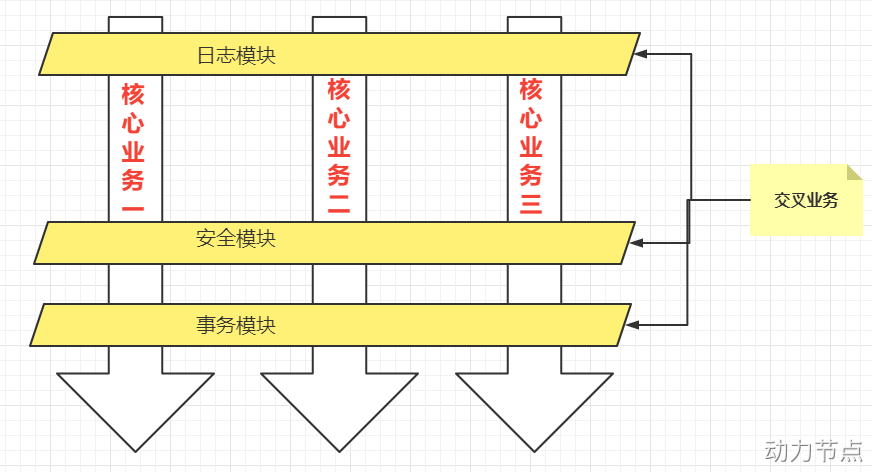
用一句话总结AOP:将与核心业务无关的代码独立的抽取出来,形成一个独立的组件,然后以横向交叉的方式应用到业务流程当中的过程被称为AOP。
(三)AOP的优点
- 第一:代码复用性增强。
- 第二:代码易维护。
- 第三:使开发者更关注业务逻辑。
(四)AOP的七大术语
public class UserService{
public void do1(){
System.out.println("do 1");
}
public void do2(){
System.out.println("do 2");
}
public void do3(){
System.out.println("do 3");
}
public void do4(){
System.out.println("do 4");
}
public void do5(){
System.out.println("do 5");
}
// 核心业务方法
public void service(){
do1();
do2();
do3();
do5();
}
}
-
连接点
Joinpoint -
- 在程序的整个执行流程中,可以织入切面的位置。方法的执行前后,异常抛出之后等位置。
-
切点
Pointcut -
- 在程序执行流程中,真正织入切面的方法。(一个切点对应多个连接点)
-
通知
Advice -
- 通知又叫增强,就是具体你要织入的代码。
- 通知包括:
-
-
- 前置通知
- 后置通知
- 环绕通知
- 异常通知
- 最终通知
-
-
切面
Aspect -
- 切点 + 通知就是切面。
-
织入
Weaving -
- 把通知应用到目标对象上的过程。
-
代理对象
Proxy -
- 一个目标对象被织入通知后产生的新对象。
-
目标对象
Target -
- 被织入通知的对象。
通过下图,大家可以很好的理解AOP的相关术语:
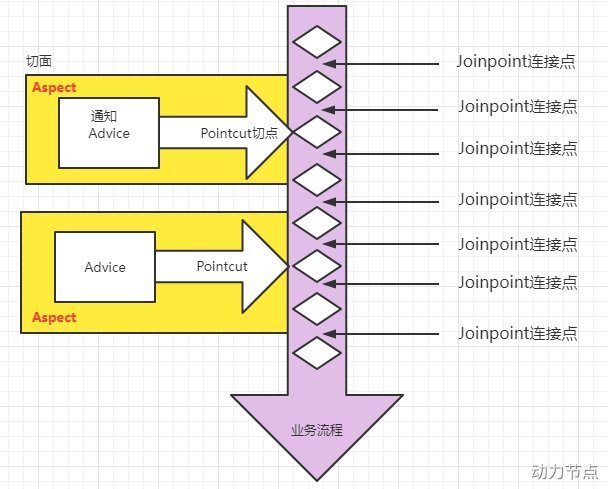
三、AOP切点表达式
切点表达式用来定义通知(Advice)往哪些方法上切入。
切入点表达式语法格式:
execution([访问控制权限修饰符] 返回值类型 [全限定类名]方法名(形式参数列表) [异常])
访问控制权限修饰符:
- 可选项。
- 没写,就是4个权限都包括。
- 写
public就表示只包括公开的方法。
返回值类型:
- 必填项。
- * 表示返回值类型任意。
全限定类名:
- 可选项。
- 两个点“..”代表当前包以及子包下的所有类。
- 省略时表示所有的类。
方法名:
- 必填项。
- *表示所有方法。
- set*表示所有的set方法。
形式参数列表:
-
必填项
-
() 表示没有参数的方法
-
(..) 参数类型和个数随意的方法
-
(*) 只有一个参数的方法
-
(*, String) 第一个参数类型随意,第二个参数是String的。
异常:
- 可选项。
- 省略时表示任意异常类型。
理解以下的切点表达式:
service包下所有的类中以delete开始的所有方法:
execution(public * com.powernode.mall.service.*.delete*(..))
mall包下所有的类的所有的方法:
execution(* com.powernode.mall..*(..))
所有类的所有方法:
execution(* *(..))
四、使用Spring的AOP
Spring对AOP的实现包括以下3种方式:
- 第一种方式:
Spring框架结合AspectJ框架实现的AOP,基于注解方式。(重点掌握) - 第二种方式:
Spring框架结合AspectJ框架实现的AOP,基于XML方式。 - 第三种方式:
Spring框架自己实现的AOP,基于XML配置方式。
实际开发中,都是Spring+AspectJ来实现AOP。所以我们重点学习第一种和第二种方式。
什么是AspectJ?(Eclipse组织的一个支持AOP的框架。AspectJ框架是独立于Spring框架之外的一个框架,Spring框架用了AspectJ)
AspectJ项目起源于帕洛阿尔托(Palo Alto)研究中心(缩写为PARC)。该中心由Xerox集团资助,Gregor Kiczales领导,从1997年开始致力于AspectJ的开发,1998年第一次发布给外部用户,2001年发布1.0 release。为了推动AspectJ技术和社团的发展,PARC在2003年3月正式将AspectJ项目移交给了Eclipse组织,因为AspectJ的发展和受关注程度大大超出了PARC的预期,他们已经无力继续维持它的发展。
(一)准备工作
使用Spring+AspectJ的AOP需要引入的依赖如下:
pom.xml
<!--spring context依赖-->
<dependency>
<groupId>org.springframework</groupId>
<artifactId>spring-context</artifactId>
<version>6.0.0-M2</version>
</dependency>
<!--spring aop依赖-->
<dependency>
<groupId>org.springframework</groupId>
<artifactId>spring-aop</artifactId>
<version>6.0.0-M2</version>
</dependency>
<!--spring aspects依赖-->
<dependency>
<groupId>org.springframework</groupId>
<artifactId>spring-aspects</artifactId>
<version>6.0.0-M2</version>
</dependency>
Spring配置文件中添加context命名空间和aop命名空间
spring-aspectj-aop-annotation.xml
<?xml version="1.0" encoding="UTF-8"?>
<beans xmlns="http://www.springframework.org/schema/beans"
xmlns:xsi="http://www.w3.org/2001/XMLSchema-instance"
xmlns:context="http://www.springframework.org/schema/context"
xmlns:aop="http://www.springframework.org/schema/aop"
xsi:schemaLocation="http://www.springframework.org/schema/beans http://www.springframework.org/schema/beans/spring-beans.xsd
http://www.springframework.org/schema/context http://www.springframework.org/schema/context/spring-context.xsd
http://www.springframework.org/schema/aop http://www.springframework.org/schema/aop/spring-aop.xsd">
</beans>
(二)基于AspectJ的AOP注解式开发
① 实现步骤
第一步:定义目标类以及目标方法
目标类:
package com.powernode.spring6.service;
// 目标类
public class OrderService {
// 目标方法
public void generate(){
System.out.println("订单已生成!");
}
}
第二步:定义切面类
切面类:
package com.powernode.spring6.service;
import org.aspectj.lang.annotation.Aspect;
// 切面类
@Aspect
public class MyAspect {
}
第三步:目标类和切面类都纳入spring bean管理
在目标类OrderService上添加@Component注解。
在切面类MyAspect类上添加@Component注解。
第四步:在spring配置文件中添加组建扫描
spring-aspectj-aop-annotation.xml
<?xml version="1.0" encoding="UTF-8"?>
<beans xmlns="http://www.springframework.org/schema/beans"
xmlns:xsi="http://www.w3.org/2001/XMLSchema-instance"
xmlns:context="http://www.springframework.org/schema/context"
xmlns:aop="http://www.springframework.org/schema/aop"
xsi:schemaLocation="http://www.springframework.org/schema/beans http://www.springframework.org/schema/beans/spring-beans.xsd
http://www.springframework.org/schema/context http://www.springframework.org/schema/context/spring-context.xsd
http://www.springframework.org/schema/aop http://www.springframework.org/schema/aop/spring-aop.xsd">
<!--开启组件扫描-->
<context:component-scan base-package="com.powernode.spring6.service"/>
</beans>
第五步:在切面类中添加通知
package com.powernode.spring6.service;
import org.springframework.stereotype.Component;
import org.aspectj.lang.annotation.Aspect;
// 切面类
@Aspect
@Component
public class MyAspect {
// 这就是需要增强的代码(通知)
public void advice(){
System.out.println("我是一个通知");
}
}
第六步:在通知上添加切点表达式
通知+切点=切面
package com.powernode.spring6.service;
import org.aspectj.lang.annotation.Before;
import org.springframework.stereotype.Component;
import org.aspectj.lang.annotation.Aspect;
// 切面类
@Aspect
@Component
public class MyAspect {
// 切点表达式
@Before("execution(* com.powernode.spring6.service.OrderService.*(..))")
// 这就是需要增强的代码(通知)
public void advice(){
System.out.println("我是一个通知");
}
}
注解@Before表示前置通知。
第七步:在spring配置文件中启用自动代理
spring-aspectj-aop-annotation.xml
<?xml version="1.0" encoding="UTF-8"?>
<beans xmlns="http://www.springframework.org/schema/beans"
xmlns:xsi="http://www.w3.org/2001/XMLSchema-instance"
xmlns:context="http://www.springframework.org/schema/context"
xmlns:aop="http://www.springframework.org/schema/aop"
xsi:schemaLocation="http://www.springframework.org/schema/beans http://www.springframework.org/schema/beans/spring-beans.xsd
http://www.springframework.org/schema/context http://www.springframework.org/schema/context/spring-context.xsd
http://www.springframework.org/schema/aop http://www.springframework.org/schema/aop/spring-aop.xsd">
<!--开启组件扫描-->
<context:component-scan base-package="com.powernode.spring6.service"/>
<!--开启自动代理-->
<aop:aspectj-autoproxy proxy-target-class="true"/>
</beans>
<aop:aspectj-autoproxy proxy-target-class="true"/> 开启自动代理之后,凡事带有@Aspect注解的bean都会生成代理对象。
proxy-target-class="true" 表示采用cglib动态代理。
proxy-target-class="false" 表示采用jdk动态代理。默认值是false。即使写成false,当没有接口的时候,也会自动选择cglib生成代理类。
测试程序:
package com.powernode.spring6.test;
import com.powernode.spring6.service.OrderService;
import org.junit.Test;
import org.springframework.context.ApplicationContext;
import org.springframework.context.support.ClassPathXmlApplicationContext;
public class AOPTest {
@Test
public void testAOP(){
ApplicationContext applicationContext = new ClassPathXmlApplicationContext("spring-aspectj-aop-annotation.xml");
OrderService orderService = applicationContext.getBean("orderService", OrderService.class);
orderService.generate();
}
}
运行结果:
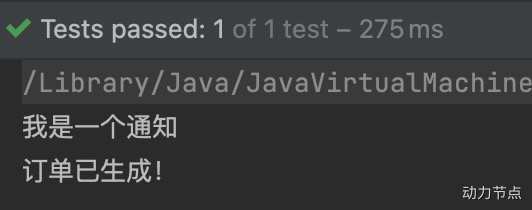
② 通知类型
通知类型包括:
- 前置通知:
@Before目标方法执行之前的通知 - 后置通知:
@AfterReturning目标方法执行之后的通知 - 环绕通知:
@Around目标方法之前添加通知,同时目标方法执行之后添加通知。 - 异常通知:
@AfterThrowing发生异常之后执行的通知 - 最终通知:
@After放在finally语句块中的通知
接下来,编写程序来测试这几个通知的执行顺序:
MyAspect
package com.powernode.spring6.service;
import org.aspectj.lang.ProceedingJoinPoint;
import org.aspectj.lang.annotation.*;
import org.springframework.stereotype.Component;
// 切面类
@Component
@Aspect
public class MyAspect {
@Around("execution(* com.powernode.spring6.service.OrderService.*(..))")
public void aroundAdvice(ProceedingJoinPoint proceedingJoinPoint) throws Throwable {
System.out.println("环绕通知开始");
// 执行目标方法。
proceedingJoinPoint.proceed();
System.out.println("环绕通知结束");
}
@Before("execution(* com.powernode.spring6.service.OrderService.*(..))")
public void beforeAdvice(){
System.out.println("前置通知");
}
@AfterReturning("execution(* com.powernode.spring6.service.OrderService.*(..))")
public void afterReturningAdvice(){
System.out.println("后置通知");
}
@AfterThrowing("execution(* com.powernode.spring6.service.OrderService.*(..))")
public void afterThrowingAdvice(){
System.out.println("异常通知");
}
@After("execution(* com.powernode.spring6.service.OrderService.*(..))")
public void afterAdvice(){
System.out.println("最终通知");
}
}
目标类和目标方法
package com.powernode.spring6.service;
import org.springframework.stereotype.Component;
// 目标类
@Component
public class OrderService {
// 目标方法
public void generate(){
System.out.println("订单已生成!");
}
}
测试程序
package com.powernode.spring6.test;
import com.powernode.spring6.service.OrderService;
import org.junit.Test;
import org.springframework.context.ApplicationContext;
import org.springframework.context.support.ClassPathXmlApplicationContext;
public class AOPTest {
@Test
public void testAOP(){
ApplicationContext applicationContext = new ClassPathXmlApplicationContext("spring-aspectj-aop-annotation.xml");
OrderService orderService = applicationContext.getBean("orderService", OrderService.class);
orderService.generate();
}
}
执行结果:
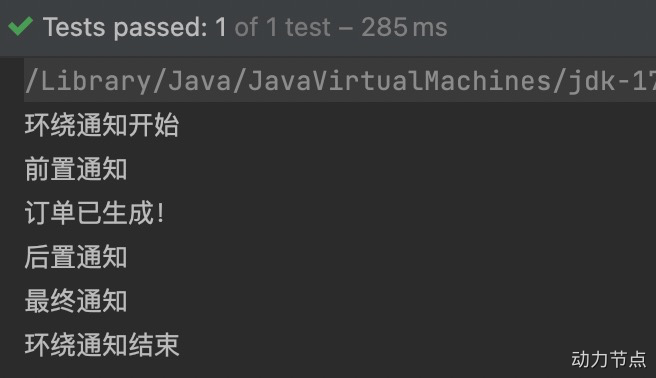
通过上面的执行结果就可以判断他们的执行顺序了,这里不再赘述。
结果中没有异常通知,这是因为目标程序执行过程中没有发生异常。我们尝试让目标方法发生异常:
让目标方法执行过程中发生异常
package com.powernode.spring6.service;
import org.springframework.stereotype.Component;
// 目标类
@Component
public class OrderService {
// 目标方法
public void generate(){
System.out.println("订单已生成!");
if (1 == 1) {
throw new RuntimeException("模拟异常发生");
}
}
}
再次执行测试程序,结果如下:
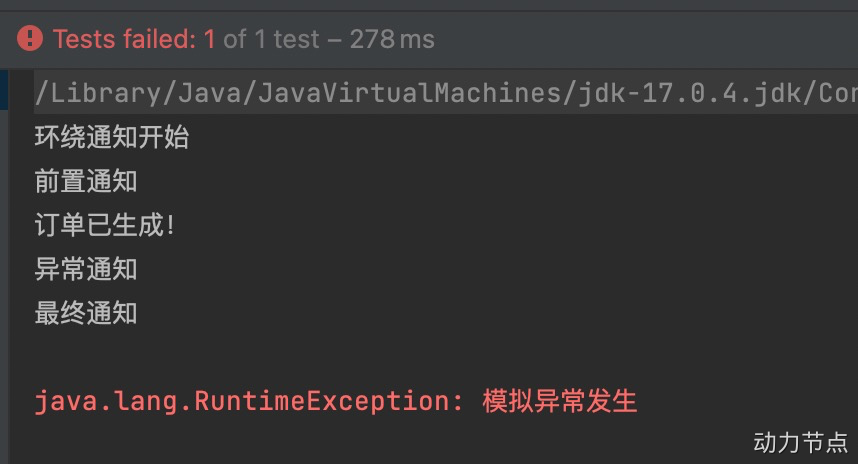
通过测试得知,当发生异常之后,最终通知也会执行,因为最终通知@After会出现在finally语句块中。
出现异常之后,后置通知和环绕通知的结束部分不会执行。
③ 切面的先后顺序
我们知道,业务流程当中不一定只有一个切面,可能有的切面控制事务,有的记录日志,有的进行安全控制,如果多个切面的话,顺序如何控制:可以使用@Order注解来标识切面类,为@Order注解的value指定一个整数型的数字,数字越小,优先级越高。
再定义一个切面类,如下:
另一个切面类,并设置优先级
package com.powernode.spring6.service;
import org.aspectj.lang.ProceedingJoinPoint;
import org.aspectj.lang.annotation.*;
import org.springframework.core.annotation.Order;
import org.springframework.stereotype.Component;
@Aspect
@Component
@Order(1) //设置优先级
public class YourAspect {
@Around("execution(* com.powernode.spring6.service.OrderService.*(..))")
public void aroundAdvice(ProceedingJoinPoint proceedingJoinPoint) throws Throwable {
System.out.println("YourAspect环绕通知开始");
// 执行目标方法。
proceedingJoinPoint.proceed();
System.out.println("YourAspect环绕通知结束");
}
@Before("execution(* com.powernode.spring6.service.OrderService.*(..))")
public void beforeAdvice(){
System.out.println("YourAspect前置通知");
}
@AfterReturning("execution(* com.powernode.spring6.service.OrderService.*(..))")
public void afterReturningAdvice(){
System.out.println("YourAspect后置通知");
}
@AfterThrowing("execution(* com.powernode.spring6.service.OrderService.*(..))")
public void afterThrowingAdvice(){
System.out.println("YourAspect异常通知");
}
@After("execution(* com.powernode.spring6.service.OrderService.*(..))")
public void afterAdvice(){
System.out.println("YourAspect最终通知");
}
}
设置切面类MyAspect的优先级
package com.powernode.spring6.service;
import org.aspectj.lang.ProceedingJoinPoint;
import org.aspectj.lang.annotation.*;
import org.springframework.core.annotation.Order;
import org.springframework.stereotype.Component;
// 切面类
@Component
@Aspect
@Order(2) //设置优先级
public class MyAspect {
@Around("execution(* com.powernode.spring6.service.OrderService.*(..))")
public void aroundAdvice(ProceedingJoinPoint proceedingJoinPoint) throws Throwable {
System.out.println("环绕通知开始");
// 执行目标方法。
proceedingJoinPoint.proceed();
System.out.println("环绕通知结束");
}
@Before("execution(* com.powernode.spring6.service.OrderService.*(..))")
public void beforeAdvice(){
System.out.println("前置通知");
}
@AfterReturning("execution(* com.powernode.spring6.service.OrderService.*(..))")
public void afterReturningAdvice(){
System.out.println("后置通知");
}
@AfterThrowing("execution(* com.powernode.spring6.service.OrderService.*(..))")
public void afterThrowingAdvice(){
System.out.println("异常通知");
}
@After("execution(* com.powernode.spring6.service.OrderService.*(..))")
public void afterAdvice(){
System.out.println("最终通知");
}
}
执行测试程序:

通过修改@Order注解的整数值来切换顺序,执行测试程序:
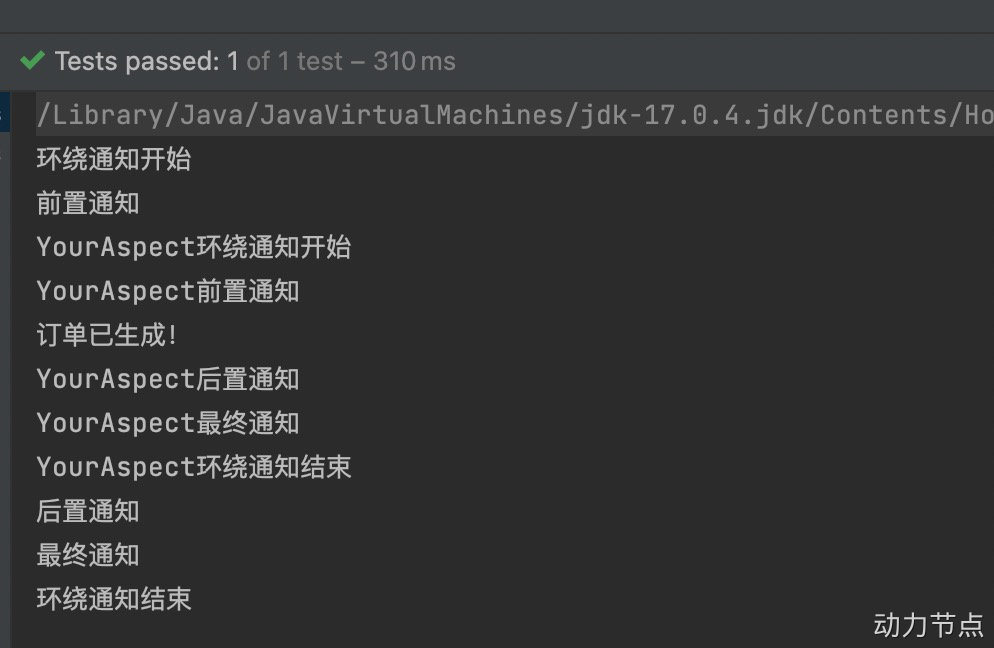
④ 优化使用切点表达式
观看以下代码中的切点表达式:
package com.powernode.spring6.service;
import org.aspectj.lang.ProceedingJoinPoint;
import org.aspectj.lang.annotation.*;
import org.springframework.core.annotation.Order;
import org.springframework.stereotype.Component;
// 切面类
@Component
@Aspect
@Order(2)
public class MyAspect {
@Around("execution(* com.powernode.spring6.service.OrderService.*(..))")
public void aroundAdvice(ProceedingJoinPoint proceedingJoinPoint) throws Throwable {
System.out.println("环绕通知开始");
// 执行目标方法。
proceedingJoinPoint.proceed();
System.out.println("环绕通知结束");
}
@Before("execution(* com.powernode.spring6.service.OrderService.*(..))")
public void beforeAdvice(){
System.out.println("前置通知");
}
@AfterReturning("execution(* com.powernode.spring6.service.OrderService.*(..))")
public void afterReturningAdvice(){
System.out.println("后置通知");
}
@AfterThrowing("execution(* com.powernode.spring6.service.OrderService.*(..))")
public void afterThrowingAdvice(){
System.out.println("异常通知");
}
@After("execution(* com.powernode.spring6.service.OrderService.*(..))")
public void afterAdvice(){
System.out.println("最终通知");
}
}
缺点是:
- 第一:切点表达式重复写了多次,没有得到复用。
- 第二:如果要修改切点表达式,需要修改多处,难维护。
可以这样做:将切点表达式单独的定义出来,在需要的位置引入即可。如下:
package com.powernode.spring6.service;
import org.aspectj.lang.ProceedingJoinPoint;
import org.aspectj.lang.annotation.*;
import org.springframework.core.annotation.Order;
import org.springframework.stereotype.Component;
// 切面类
@Component
@Aspect
@Order(2)
public class MyAspect {
@Pointcut("execution(* com.powernode.spring6.service.OrderService.*(..))")
public void pointcut(){}
@Around("pointcut()")
public void aroundAdvice(ProceedingJoinPoint proceedingJoinPoint) throws Throwable {
System.out.println("环绕通知开始");
// 执行目标方法。
proceedingJoinPoint.proceed();
System.out.println("环绕通知结束");
}
@Before("pointcut()")
public void beforeAdvice(){
System.out.println("前置通知");
}
@AfterReturning("pointcut()")
public void afterReturningAdvice(){
System.out.println("后置通知");
}
@AfterThrowing("pointcut()")
public void afterThrowingAdvice(){
System.out.println("异常通知");
}
@After("pointcut()")
public void afterAdvice(){
System.out.println("最终通知");
}
}
使用@Pointcut注解来定义独立的切点表达式。
注意这个@Pointcut注解标注的方法随意,只是起到一个能够让@Pointcut注解编写的位置。
执行测试程序:

⑤ 全注解式开发AOP
就是编写一个类,在这个类上面使用大量注解来代替spring的配置文件,spring配置文件消失了,如下:
package com.powernode.spring6.service;
import org.springframework.context.annotation.ComponentScan;
import org.springframework.context.annotation.Configuration;
import org.springframework.context.annotation.EnableAspectJAutoProxy;
@Configuration
@ComponentScan("com.powernode.spring6.service")
@EnableAspectJAutoProxy(proxyTargetClass = true)
public class Spring6Configuration {
}
测试程序也变化了:
@Test
public void testAOPWithAllAnnotation(){
ApplicationContext applicationContext = new AnnotationConfigApplicationContext(Spring6Configuration.class);
OrderService orderService = applicationContext.getBean("orderService", OrderService.class);
orderService.generate();
}
执行结果如下:

(三)基于XML配置方式的AOP(了解)
第一步:编写目标类
不添加@Component注解
package com.powernode.spring6.service;
// 目标类
public class VipService {
public void add(){
System.out.println("保存vip信息。");
}
}
第二步:编写切面类,并且编写通知
不添加@Component注解
package com.powernode.spring6.service;
import org.aspectj.lang.ProceedingJoinPoint;
// 负责计时的切面类
public class TimerAspect {
public void time(ProceedingJoinPoint proceedingJoinPoint) throws Throwable {
long begin = System.currentTimeMillis();
//执行目标
proceedingJoinPoint.proceed();
long end = System.currentTimeMillis();
System.out.println("耗时"+(end - begin)+"毫秒");
}
}
第三步:编写spring配置文件
spring-aop-xml.xml
<?xml version="1.0" encoding="UTF-8"?>
<beans xmlns="http://www.springframework.org/schema/beans"
xmlns:xsi="http://www.w3.org/2001/XMLSchema-instance"
xmlns:context="http://www.springframework.org/schema/context"
xmlns:aop="http://www.springframework.org/schema/aop"
xsi:schemaLocation="http://www.springframework.org/schema/beans http://www.springframework.org/schema/beans/spring-beans.xsd
http://www.springframework.org/schema/context http://www.springframework.org/schema/context/spring-context.xsd
http://www.springframework.org/schema/aop http://www.springframework.org/schema/aop/spring-aop.xsd">
<!--纳入spring bean管理-->
<bean id="vipService" class="com.powernode.spring6.service.VipService"/>
<bean id="timerAspect" class="com.powernode.spring6.service.TimerAspect"/>
<!--aop配置-->
<aop:config>
<!--切点表达式-->
<aop:pointcut id="p" expression="execution(* com.powernode.spring6.service.VipService.*(..))"/>
<!--切面-->
<aop:aspect ref="timerAspect">
<!--切面=通知 + 切点-->
<aop:around method="time" pointcut-ref="p"/>
</aop:aspect>
</aop:config>
</beans>
测试程序:
package com.powernode.spring6.test;
import com.powernode.spring6.service.VipService;
import org.junit.Test;
import org.springframework.context.ApplicationContext;
import org.springframework.context.support.ClassPathXmlApplicationContext;
public class AOPTest3 {
@Test
public void testAOPXml(){
ApplicationContext applicationContext = new ClassPathXmlApplicationContext("spring-aop-xml.xml");
VipService vipService = applicationContext.getBean("vipService", VipService.class);
vipService.add();
}
}
执行结果:
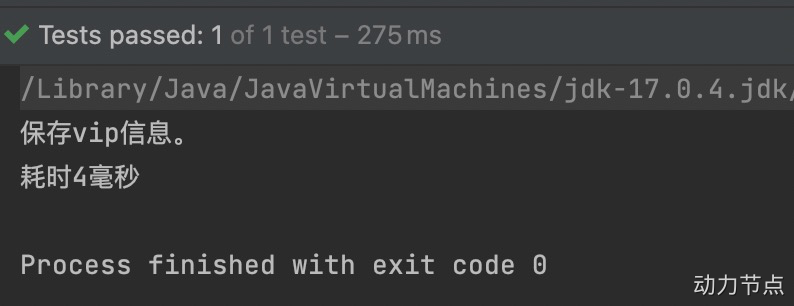
五、AOP的实际案例解决方案
(一)事务处理
项目中的事务控制是在所难免的。在一个业务流程当中,可能需要多条DML语句共同完成,为了保证数据的安全,这多条DML语句要么同时成功,要么同时失败。这就需要添加事务控制的代码。例如以下伪代码:
伪代码
class 业务类1{
public void 业务方法1(){
try{
// 开启事务
startTransaction();
// 执行核心业务逻辑
step1();
step2();
step3();
....
// 提交事务
commitTransaction();
}catch(Exception e){
// 回滚事务
rollbackTransaction();
}
}
public void 业务方法2(){
try{
// 开启事务
startTransaction();
// 执行核心业务逻辑
step1();
step2();
step3();
....
// 提交事务
commitTransaction();
}catch(Exception e){
// 回滚事务
rollbackTransaction();
}
}
public void 业务方法3(){
try{
// 开启事务
startTransaction();
// 执行核心业务逻辑
step1();
step2();
step3();
....
// 提交事务
commitTransaction();
}catch(Exception e){
// 回滚事务
rollbackTransaction();
}
}
}
class 业务类2{
public void 业务方法1(){
try{
// 开启事务
startTransaction();
// 执行核心业务逻辑
step1();
step2();
step3();
....
// 提交事务
commitTransaction();
}catch(Exception e){
// 回滚事务
rollbackTransaction();
}
}
public void 业务方法2(){
try{
// 开启事务
startTransaction();
// 执行核心业务逻辑
step1();
step2();
step3();
....
// 提交事务
commitTransaction();
}catch(Exception e){
// 回滚事务
rollbackTransaction();
}
}
public void 业务方法3(){
try{
// 开启事务
startTransaction();
// 执行核心业务逻辑
step1();
step2();
step3();
....
// 提交事务
commitTransaction();
}catch(Exception e){
// 回滚事务
rollbackTransaction();
}
}
}
//......
可以看到,这些业务类中的每一个业务方法都是需要控制事务的,而控制事务的代码又是固定的格式,都是:
try{
// 开启事务
startTransaction();
// 执行核心业务逻辑
//......
// 提交事务
commitTransaction();
}catch(Exception e){
// 回滚事务
rollbackTransaction();
}
这个控制事务的代码就是和业务逻辑没有关系的“交叉业务”。以上伪代码当中可以看到这些交叉业务的代码没有得到复用,并且如果这些交叉业务代码需要修改,那必然需要修改多处,难维护,怎么解决?可以采用AOP思想解决。可以把以上控制事务的代码作为环绕通知,切入到目标类的方法当中。接下来我们做一下这件事,有两个业务类,如下:
银行账户的业务类:
package com.powernode.spring6.biz;
import org.springframework.stereotype.Component;
@Component
// 业务类
public class AccountService {
// 转账业务方法
public void transfer(){
System.out.println("正在进行银行账户转账");
}
// 取款业务方法
public void withdraw(){
System.out.println("正在进行取款操作");
}
}
订单业务类:
package com.powernode.spring6.biz;
import org.springframework.stereotype.Component;
@Component
// 业务类
public class OrderService {
// 生成订单
public void generate(){
System.out.println("正在生成订单");
}
// 取消订单
public void cancel(){
System.out.println("正在取消订单");
}
}
注意,以上两个业务类已经纳入spring bean的管理,因为都添加了@Component注解。
接下来我们给以上两个业务类的4个方法添加事务控制代码,使用AOP来完成:
事务切面类:
package com.powernode.spring6.biz;
import org.aspectj.lang.ProceedingJoinPoint;
import org.aspectj.lang.annotation.Around;
import org.aspectj.lang.annotation.Aspect;
import org.springframework.stereotype.Component;
@Aspect
@Component
// 事务切面类
public class TransactionAspect {
@Around("execution(* com.powernode.spring6.biz..*(..))")
public void aroundAdvice(ProceedingJoinPoint proceedingJoinPoint){
try {
System.out.println("开启事务");
// 执行目标
proceedingJoinPoint.proceed();
System.out.println("提交事务");
} catch (Throwable e) {
System.out.println("回滚事务");
}
}
}
你看,这个事务控制代码是不是只需要写一次就行了,并且修改起来也没有成本。编写测试程序:
package com.powernode.spring6.test;
import com.powernode.spring6.biz.AccountService;
import com.powernode.spring6.biz.OrderService;
import com.powernode.spring6.service.Spring6Configuration;
import org.junit.Test;
import org.springframework.context.ApplicationContext;
import org.springframework.context.annotation.AnnotationConfigApplicationContext;
public class AOPTest2 {
@Test
public void testTransaction(){
ApplicationContext applicationContext = new AnnotationConfigApplicationContext(Spring6Configuration.class);
OrderService orderService = applicationContext.getBean("orderService", OrderService.class);
AccountService accountService = applicationContext.getBean("accountService", AccountService.class);
// 生成订单
orderService.generate();
// 取消订单
orderService.cancel();
// 转账
accountService.transfer();
// 取款
accountService.withdraw();
}
}
执行结果:
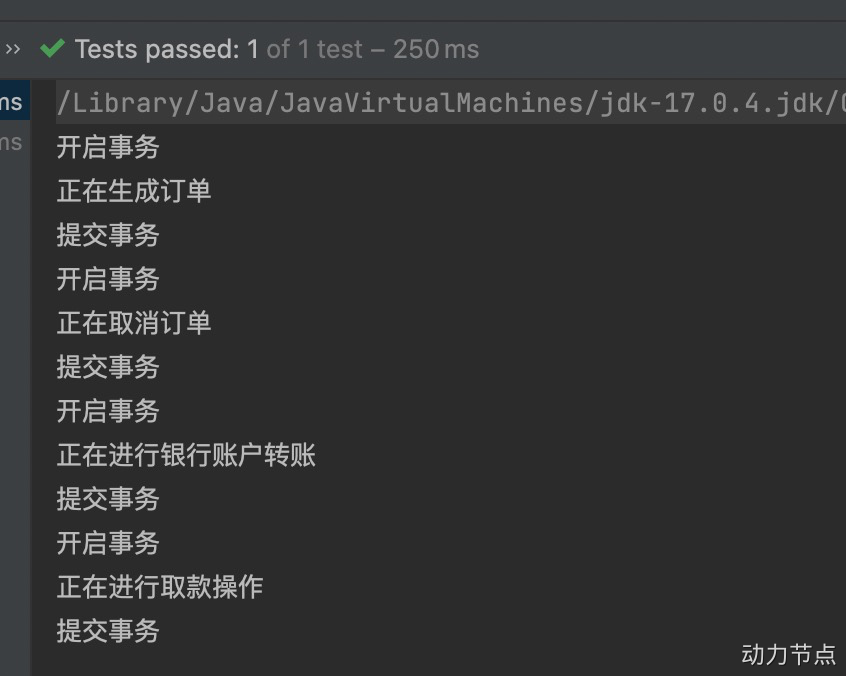
通过测试可以看到,所有的业务方法都添加了事务控制的代码。
(二)安全日志
需求是这样的:项目开发结束了,已经上线了。运行正常。客户提出了新的需求:凡事在系统中进行修改操作的,删除操作的,新增操作的,都要把这个人记录下来。因为这几个操作是属于危险行为。例如有业务类和业务方法:
用户业务类:
package com.powernode.spring6.biz;
import org.springframework.stereotype.Component;
@Component
//用户业务
public class UserService {
public void getUser(){
System.out.println("获取用户信息");
}
public void saveUser(){
System.out.println("保存用户");
}
public void deleteUser(){
System.out.println("删除用户");
}
public void modifyUser(){
System.out.println("修改用户");
}
}
商品业务类:
package com.powernode.spring6.biz;
import org.springframework.stereotype.Component;
// 商品业务类
@Component
public class ProductService {
public void getProduct(){
System.out.println("获取商品信息");
}
public void saveProduct(){
System.out.println("保存商品");
}
public void deleteProduct(){
System.out.println("删除商品");
}
public void modifyProduct(){
System.out.println("修改商品");
}
}
注意:已经添加了@Component注解。
接下来我们使用aop来解决上面的需求:编写一个负责安全的切面类
负责安全的切面类:
package com.powernode.spring6.biz;
import org.aspectj.lang.JoinPoint;
import org.aspectj.lang.annotation.Aspect;
import org.aspectj.lang.annotation.Before;
import org.aspectj.lang.annotation.Pointcut;
import org.springframework.stereotype.Component;
@Component
@Aspect
public class SecurityAspect {
@Pointcut("execution(* com.powernode.spring6.biz..save*(..))")
public void savePointcut(){}
@Pointcut("execution(* com.powernode.spring6.biz..delete*(..))")
public void deletePointcut(){}
@Pointcut("execution(* com.powernode.spring6.biz..modify*(..))")
public void modifyPointcut(){}
@Before("savePointcut() || deletePointcut() || modifyPointcut()")
public void beforeAdivce(JoinPoint joinpoint){
System.out.println("XXX操作员正在操作"+joinpoint.getSignature().getName()+"方法");
}
}
测试程序:
@Test
public void testSecurity(){
ApplicationContext applicationContext = new AnnotationConfigApplicationContext(Spring6Configuration.class);
UserService userService = applicationContext.getBean("userService", UserService.class);
ProductService productService = applicationContext.getBean("productService", ProductService.class);
userService.getUser();
userService.saveUser();
userService.deleteUser();
userService.modifyUser();
productService.getProduct();
productService.saveProduct();
productService.deleteProduct();
productService.modifyProduct();
}
执行结果:
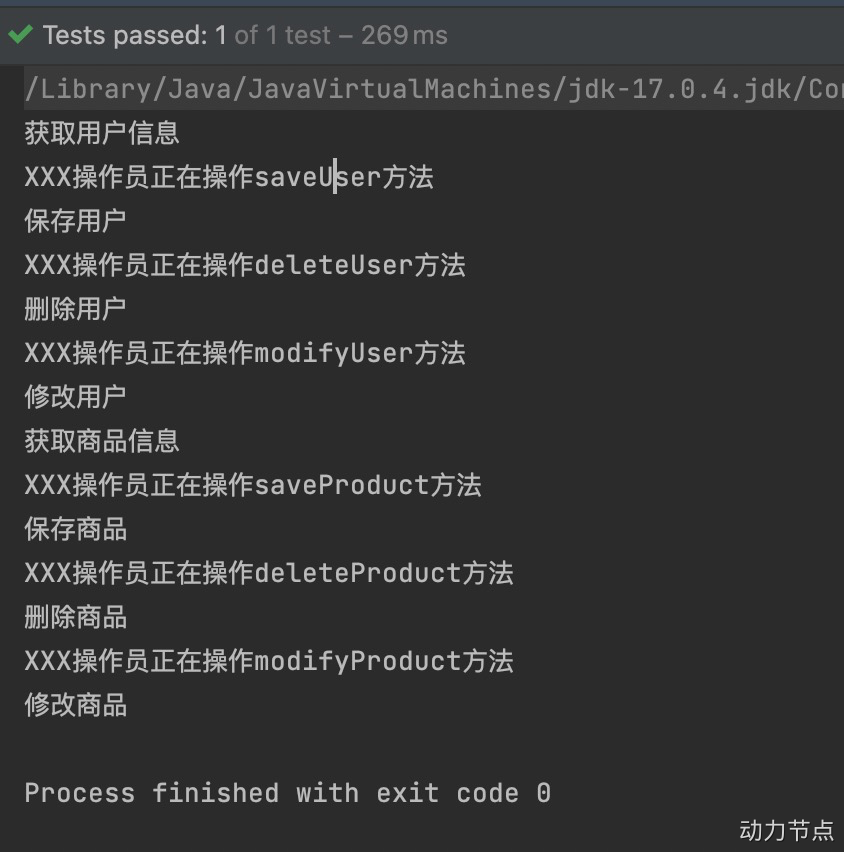
六、总结
这部分我们了解到:
AOP底层使用的就是动态代理来实现的。Spring的AOP使用的动态代理是:JDK动态代理 +CGLIB动态代理技术。Spring在这两种动态代理中灵活切换,如果是代理接口,会默认使用JDK动态代理,如果要代理某个类,这个类没有实现接口,就会切换使用CGLIB。当然,你也可以强制通过一些配置让Spring只使用CGLIB。
这里需要去了解老杜这节相关讲解,可以直接点击下面链接跳转到对应课程学习了解!